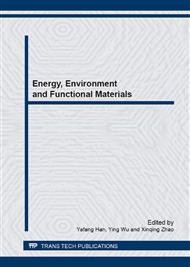[1]
B.C. Sales, D. Mandrus, R.K. Williams, Filled skutterudite antimonides: A new class of thermoelectric materials, Science 272(1996) 1325-1328.
DOI: 10.1126/science.272.5266.1325
Google Scholar
[2]
G.S. Nolas, J.L. Cohen, G.A. Slack, S.B. Schujman, Semiconducting Ge clathrates: Promising candidates for thermoelectric applications, Appl. Phys. Lett. 73(1998) 178.
DOI: 10.1063/1.121747
Google Scholar
[3]
G.J. Snyder, M. Christensen, E. Nishibori, T. Caillat, B.B. Iversenet, Disordered zinc in Zn4Sb3 with phonon-glass and electron-crystal thermoelectric properties, Nat. Mater. 3(2004) 458-463.
DOI: 10.1038/nmat1154
Google Scholar
[4]
R. Venkatasubramanian, E. Siivola, T. Colpitts, B. O'Quinn, Thin-film thermoelectric devices with high room-temperature figures of merit, Nature 413(2001) 597-602.
DOI: 10.1038/35098012
Google Scholar
[5]
T.M. Tritt, Thermoelectric materials: Principles, structure, properties, and applications, in: Encyclopedia of materials: Science and Technology (2002), pp.1-11.
DOI: 10.1016/b0-08-043152-6/01822-2
Google Scholar
[6]
K.F. Hsu, S. Loo, F. Guo, W. Chen, J.S. Dyck, C. Uher, T. Hogan, E.K. Polychroniadis, M.G. Kanatzidis, Cubic AgPbmSbTe2+m: Bulk thermoelectric materials with high figure of merit, Science 303(2004) 818-821.
DOI: 10.1002/chin.200417240
Google Scholar
[7]
Y.Q. Cao, X.B. Zhao, T.J. Zhu, X.B. Zhang, J.P. Tu, Syntheses and thermoelectric properties of Bi2Te3/Sb2Te3 bulk nanocomposites with laminated nanostructure, Appl. Phys. Lett. 92(2008) 143106
DOI: 10.1063/1.2900960
Google Scholar
[8]
I. Terasaki, High-temperature oxide thermoelectrics, J. Appl. Phys. 110(2011) 053705
Google Scholar
[9]
H. Ohta, Thermoelectrics based on strontium titanate, Mater. Today 10(2007) 44-49.
Google Scholar
[10]
S. Lee, S. Dursun, C. Duran, C.A. Randall, Thermoelectric power factor enhancement of textured ferroelectric SrxBa1–xNb2O6–δ ceramics, J. Mater. Res. 26(2011) 26-30.
DOI: 10.1557/jmr.2010.78
Google Scholar
[11]
S. Lee, R.H.T. Wilke, S. Trolier-McKinstry, S.J. Zhang; C.A. Randall, SrxBa1-xNb2O6-δ Ferroelectric-thermoelectrics: Crystal anisotropy, conduction mechanism, and power factor, Appl. Phys. Lett. 96(2010) 031910.
DOI: 10.1063/1.3291563
Google Scholar
[12]
C.L. Choy, W.P. Leung, T.G. Xi, Y. Fei, C.F. Shao, Specific heat and thermal diffusivity of strontium barium niobate Sr1−xBaxNb2O6 single crystals, J. Appl. Phys. 71(1992) 70
DOI: 10.1063/1.350732
Google Scholar
[13]
C. Kittel, Introduction to Solid State Physics, seventh ed., John Wiley, New York, 1996.
Google Scholar
[14]
E. Fischer, W. Hässler, E. Hegenbarth, Glass-Like behaviour in the thermal conductivity of Sr1−xBaxNb2O6 single crystal, Phys. Stat. Sol. (a) 72(1982) 169-171.
DOI: 10.1002/pssa.2210720261
Google Scholar
[15]
C. Kittel, Interpretation of the thermal conductivity of glasses, Phys. Rev. 75(1949) 972-974.
DOI: 10.1103/physrev.75.972
Google Scholar
[16]
Y.F. Wang, F. Yang, P. Xiao, Rattlers or oxygen vacancies: Determinant of high temperature plateau thermal conductivity in doped pyrochlores, Appl. Phys. Lett., 102(2013) 141902.
DOI: 10.1063/1.4801319
Google Scholar


